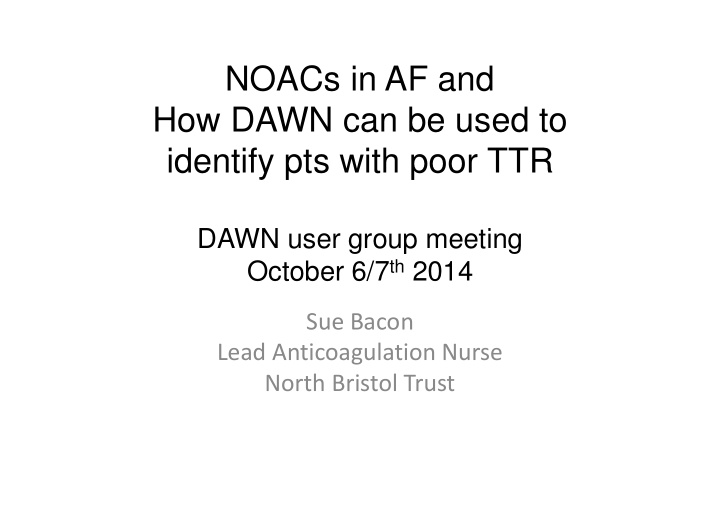



NOACs in AF and How DAWN can be used to identify pts with poor TTR DAWN user group meeting October 6/7 th 2014 Sue Bacon Lead Anticoagulation Nurse North Bristol Trust
Me! • Thrombosis nurse in Scarborough • Lead anticoagulation nurse in North Bristol • Passionate about improving both management of VTE and stroke • Sit on steering group of various committees (UKTF) not because of knowledge, but prepared to stand up and make people take notice!!
Background re AF • AF a significant preventable cause of stroke • 15% of all strokes death due to AF • 12,500 per year • The incidence of AF is predicted to rise (US figures) • Underdiganosed • Many pts:- – On aspirin or nothing – Or have a v poor TTR (VGR)
Some important numbers
150,000
150,000 150,000 strokes per year across the UK.
18,000
18,000 18,000 strokes per year across South East of England.
£12,000
£12,000 The first year costs of caring for stroke patients
186,650
186,650 186,650 living with stroke in the South East of England.
£6,000
£6,000 Costs of caring for stroke patients per year
Long term trends in AF stroke • To insert when I have the data • Jon is getting me 10yr trend in AF stroke….
Background • Over the years increasingly more attention given to Rx of AF • Numerous educational events – ie SPAF Acadamy, study days, conferences - supported by pharma • Grasp AF tool • New NICE guidance (June 2014) • But still both diagnosis and management of AF (anticoagulation) need improvement
How can we improve this? • Ideally situated to identify those pts with poor TTR (VGR) • We see it very day and groan!!!! • Currently at NBT dealt with on an ‘ad hoc’ basis • Letters back and forth with colleagues and DAWN • Much of the necessary info in the DAWN system -
Academic Health Science Network • In the SW – project launched re optimizing management of AF (not about diagnosing at this moment) – Promoting best practice – Identifying pt in AF but not receiving anticoag – Identifying those with poor TTR (VGR)
How?? 5 different models of care which include the following plan:- Grasp AF to identify pts with AF Assisting clinicians in reviewing the pts Assisting secondary care to identify pts with poor TTR Working out a plan of action
�������������������������
The model for GPs using DAWN • Running Grasp-AF • Using DAWN to identify pts with poor TTR • Generating a letter from DAWN • Auditing change in practice • Improvement in TTR • Or transition to NOACs • ?transfer to DAWN NOAC modules
When • Had hoped to have done by now!! • Annual leave and sickness!!! • Need to plan the letter
At present • Identifying pts with poor TTR when dosing • If time speak to GP • ?do it in the morning • In discussion with GPs about what should go into the letter – As little information as possible – SHORT AND TO THE POINT
LETTER CONTENT? • …..Following NICE guidance…. Your pt has poor TTR • ….TTR is …. • …Could you review this patient’s anticoagulation? • …..Following review it may be appropriate to initiate alternative anticoagulation with a NOAC • …The eGFR is…… • …The need to have renal function assessed prior to prescribing a NOAC
Follow up audit • Nos of letter sent out • Outcomes • No of new refs
NOACs used at NBT 350 300 250 200 apixaban dabigatran 150 rivaroxban 100 50 0 2011-2013 2012-2013 2013-2014
Reasons for stopping anaemia palliative apix bleeding phenindione falls 0% compliance 1% 0% 0% refuses 0% 0% 0% 0% error aspirin end che low TTR self dosing 0% 1% 0% 0% 1% riv LMWH 2% rip dab 4% (blank) dna 6% end moved 35% dna moved dab 9% LMWH self dosing aspirin palliative rip 16% bleeding error apix riv che 23% falls anaemia compliance low TTR phenindione refuses
AVERROES: Stroke or SEE 5600 patients, 36 countries, 522 centres ASA 81-324 mg/d RR= 0.46 0.05 95%CI= 0.33-0.64 p<0.001 Cumulative Risk 0.03 Apixaban 2.5-5 mg bd 0.0 0.01 0 3 6 9 12 18 21 Months No. at Risk ASA 2791 2720 2541 2124 1541 626 329 Apix 2809 2761 2567 2127 1523 617 353
AVERROES - Major Bleeding 0.005 0.010 0.015 0.020 Apixaban RR= 1.14 Cumulative Risk 95%CI= 0.74-1.75 P= 0.56 ASA 0.0 0 3 6 9 12 18 21 Months No. at Risk ASA 2791 2744 2572 2152 1570 642 340 Apix 2809 2763 2567 2123 1521 622 357 N Engl J Med . 2011;364:806-817
Thoughts? • How will increased use of NOACs impact on anticoag services • Need to diversify and think about the future • Do you use the NOACs modules • How is managing NOACs in anticoag clinics funded? – need to liaise with CCGs • How are you mangaging poor TTR/VGR?
Contact • Sue.bacon@nbt.nhs.uk • suebacon@me.com • 07979696938
Recommend
More recommend